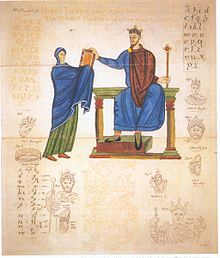| Mieszko II Lambert | |
|---|---|
 Mieszko Lambert receiving a liturgical book from Matilda of Swabia, 1000–1025 | |
| King of Poland | |
| Reign | 1025–1031 |
| Coronation | 25 December 1025 Gniezno Cathedral |
| Predecessor | Bolesław I the Brave |
| Successor | Bolesław the Forgotten |
| Duke of Poland | |
| Reign | 1032–1034 |
| Born | c. 990 |
| Died | 10 or 11 May 1034 Poznań (?) |
| Burial | 10 or 11 May 1034 |
| Spouse | Richeza of Lotharingia |
| Issue | Richeza, Queen of Hungary Casimir I, Duke of Poland Gertruda, Grand Princess of Kiev |
| Dynasty | Piast |
| Father | Bolesław I the Brave |
| Mother | Emnilda of Lusatia |
| Religion | Chalcedonian Christianity |
Mieszko II Lambert (Polish pronunciation: [ˈmjɛʂkɔ ˈdruɡʲi ˈlambɛrt] ; c. 990 – 10/11 May 1034) was King of Poland from 1025 to 1031, and Duke from 1032 until his death.
He was the second son of Bolesław I the Brave, but the eldest born from his third wife Emnilda of Lusatia. He organized two devastating invasions of Saxony in 1028 and 1030. Then, Mieszko II ran a defensive war against Germany, Bohemia and the Kievan princes. Mieszko II was forced to escape from the country in 1031 after an attack by Yaroslav I the Wise, who installed Mieszko's older half-brother Bezprym onto the Polish throne. Mieszko II took refuge in Bohemia, where he was imprisoned by the Duke Oldrich. In 1032 he regained power in one of the three districts, then united the country, making good use of the remaining power structures. At this time, several Polish territorial acquisitions of his father were lost: Upper Lusatia (also known as Milsko), part of Lower Lusatia, Red Ruthenia, the western and central parts of Upper Hungary (now Slovakia), and probably Moravia.
Mieszko II was very well educated for the period. He was able to read and write, and knew both Greek and Latin. He is unjustly known as Mieszko II Gnuśny (the "Lazy", "Stagnant" or "Slothful"). He received that epithet due to the unfortunate way his reign ended; but in the beginning he acted as a skillful and talented ruler.